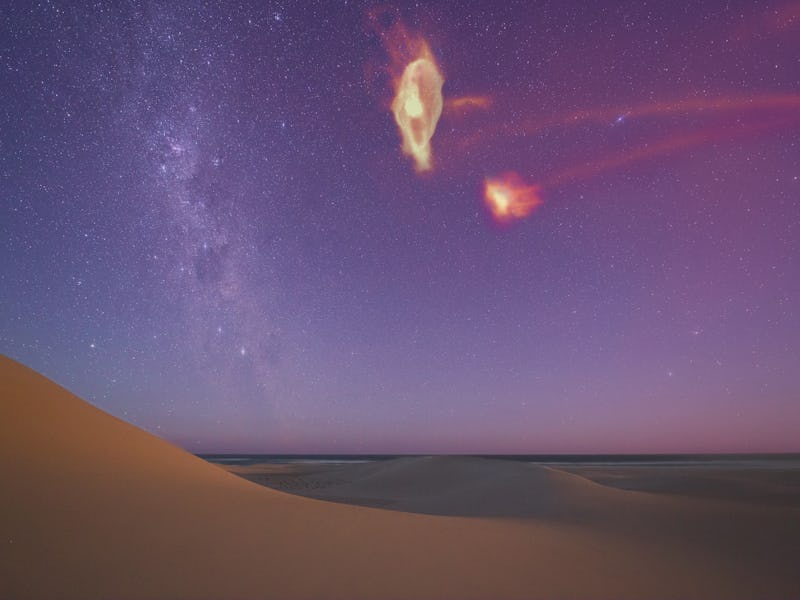Scientists uncover mystery of massive stream of gas surrounding the Milky Way
The discovery may finally explain how the Magellanic Stream came to be.

A few billion years ago, the Milky Way galaxy captured two irregular dwarf galaxies in its orbit using the pull of its gravitational force.
These two galaxies became known as the Large Magellanic Cloud and the Small Magellanic Cloud, and they can be spotted by the naked eye in the Southern Hemisphere.
But beyond the two orbiting galaxies, something even more peculiar was swirling around.
Pulled apart from the clouds, a giant stream of gas known as the Magellanic Stream extends between the two. Stretching across half of the night sky, it is a massive structure — over a billion times the mass of the Sun.
Astronomers have been trying to crack the mystery of this giant stream of gas, unclear as to how it grew to its massive size. But a new study describes how a halo of warm gas wrapped itself around the Magellanic Stream, protecting it like a cosmic cocoon, allowing it to grow.
The study was published Wednesday in the journal Nature.
The Magellanic Stream stretches halfway across the night sky.
The Magellanic Clouds are located approximately 163,000 and 206,000 light years away from Earth, appearing as broken-off, blurry specs in the Southern Hemisphere's sky. As they orbit our galaxy, the gravitational pull of the Milky Way distorts them, but their own gravitational pull has affected the outer part of the Milky Way's disc, too.
A stream of hydrogen connects them to the Milky Way and to each other — the Magellanic Stream.
Astronomers believe the Stream was ripped away from the galaxies billions of years ago. But its enormous mass had puzzled astronomers — how could such a gigantic structure form?
Previous theories had suggested that the gravitational tides and force of the two galaxies pushing against one another as they began orbiting the Milky Way formed the Magellanic Stream. But these models account for just a tenth of the stream's mass.
"The existing models of the formation of the Magellanic Stream are outdated because they can't account for its mass," Scott Lucchini, a graduate student at the University of Wisconsin-Madison's department of physics, and lead author of the new study, said in a statement.
In the new study, researchers created a new simulation that incorporated the fact that the Magellanic Clouds are massive enough to have their own halos — warm gas shields — encircling them. This, they theorized, would enable them to more accurately tease out the formation of the Magellanic Stream.
Using the simulation, the team of astronomers discovered that the halo of warm gas that surrounds the Magellanic Clouds could act as a protective shield around the Magellanic Stream — that may explain how it became as massive as it did.
The infall of the Magellanic Clouds towards the Milky Way. Observational data is shown on the left with the points representing ionized gas, while the simulation is shown on the right. The colors represent the line-of-sight velocity of the gas and the brightness indicates the relative density.The movie begins 550 million years ago and continues until present day. (Scott Lucchini.)
"The stream is a 50-year puzzle," Andrew Fox, an astronomer at the Space Telescope Science Institute, and co-author of the study, said in a statement. "We never had a good explanation of where it came from. What's really exciting is that we're closing in on an explanation now."
The study suggests that the Magellanic Stream formed from gas that had been stripped away by the Large Magellanic Cloud from its smaller counterpart, contributing about 10 to 20 percent of the stream's final mass.
Later on, as the clouds began orbiting the Milky Way, the corona gave up some 20 percent of its own mass to form the Magellanic Stream, which then stretched over as a giant arc in the sky through its interactions with the gravitational force of the Milky Way and its own corona.
The team of researchers behind the new study are hoping to test their hypothesis using the Hubble Space Telescope, which will be able to detect signs of the corona of gas surround the Magellanic Clouds.
The study not only sheds light on the massive structure of the Magellanic Stream, but also helps astronomers understand the area surrounding our galaxy and how the accretion of gas into the Milky Way could affect its star formation.
Abstract: The dominant gaseous structure in the Galactic halo is the Magellanic Stream. This extended network of neutral and ionized filaments surrounds the Large Magellanic Cloud (LMC) and the Small Magellanic Cloud (SMC), the two most massive satellite galaxies of the Milky Way1,2,3,4. Recent observations indicate that the LMC and SMC are on their first passage around the Galaxy5, that the Magellanic Stream is made up of gas stripped from both clouds2,6,7 and that the majority of this gas is ionized8,9. Although it has long been suspected that tidal forces10,11 and ram-pressure stripping12,13 contributed to the formation of the Magellanic Stream, models have not been able to provide a full understanding of its origins3. Several recent developments—including the discovery of dwarf galaxies associated with the Magellanic group14,15,16, determination of the high mass of the LMC17, detection of highly ionized gas near stars in the LMC18,19 and predictions of cosmological simulations20,21—support the existence of a halo of warm (roughly 500,000 kelvin) ionized gas around the LMC (the ‘Magellanic Corona’). Here we report that, by including this Magellanic Corona in hydrodynamic simulations of the Magellanic Clouds falling onto the Milky Way, we can reproduce the Magellanic Stream and its leading arm. Our simulations explain the filamentary structure, spatial extent, radial-velocity gradient and total ionized-gas mass of the Magellanic Stream. We predict that the Magellanic Corona will be unambiguously observable via high-ionization absorption lines in the ultraviolet spectra of background quasars lying near the LMC.
This article was originally published on